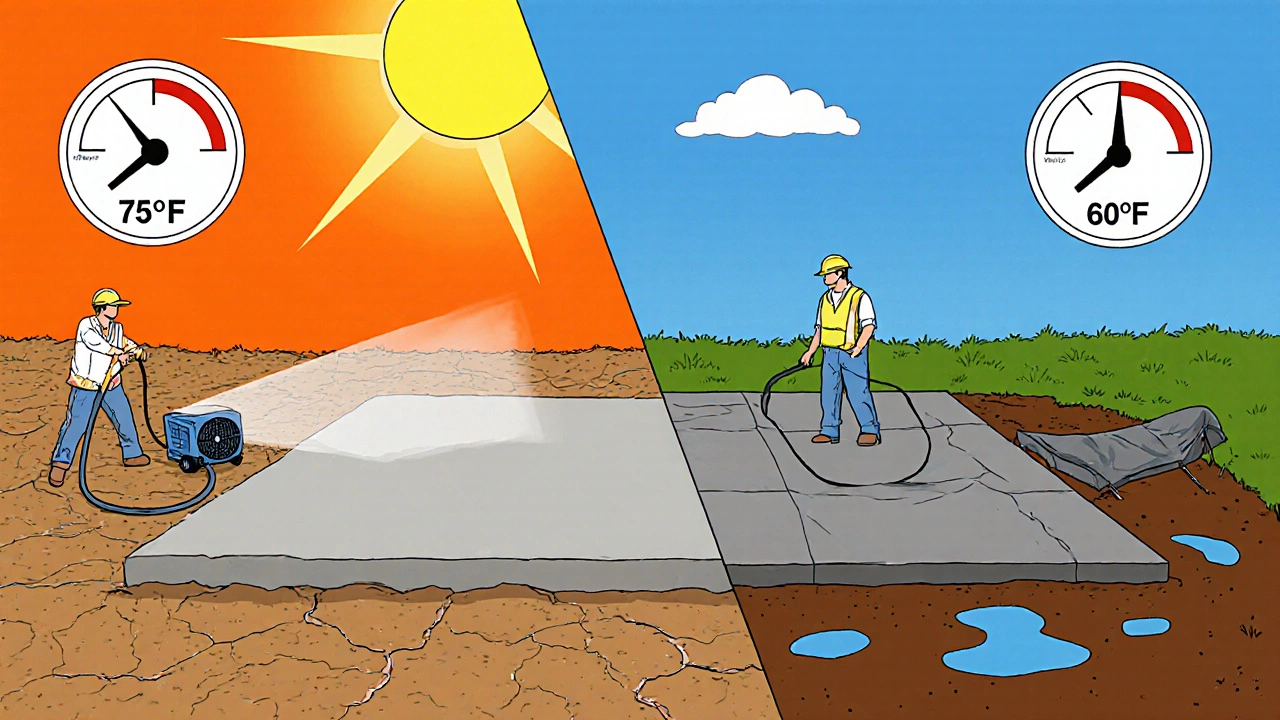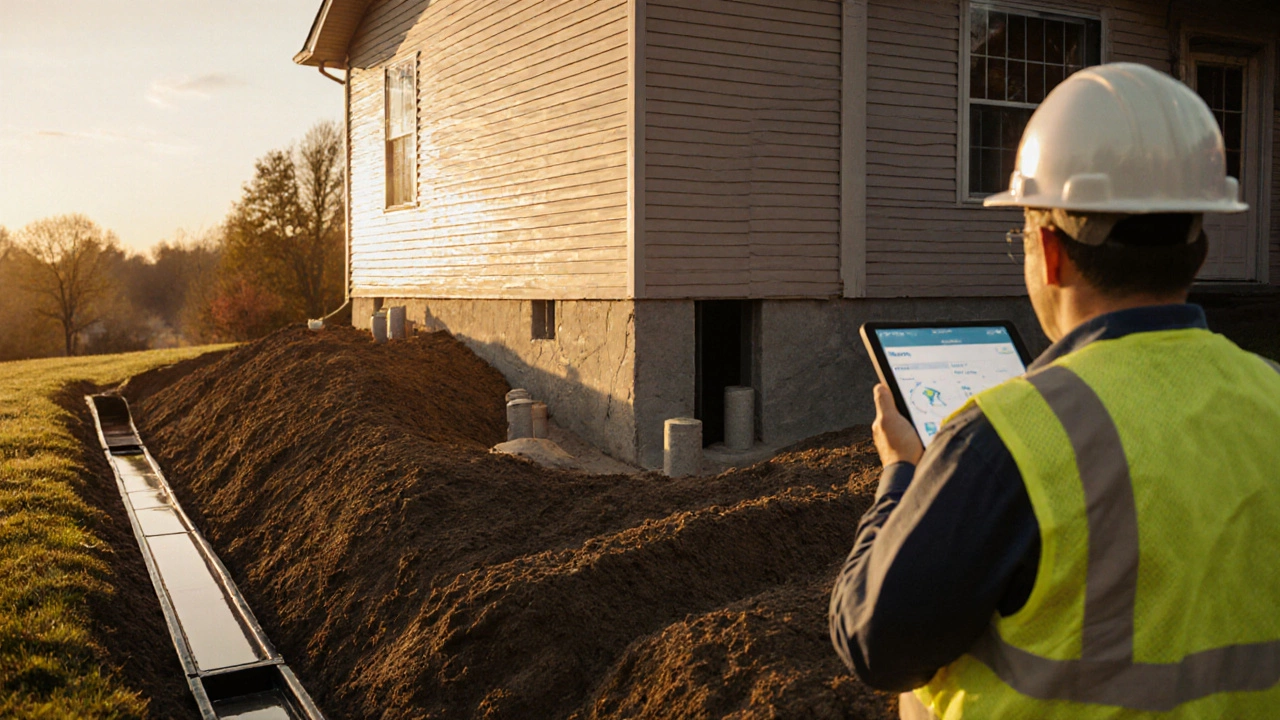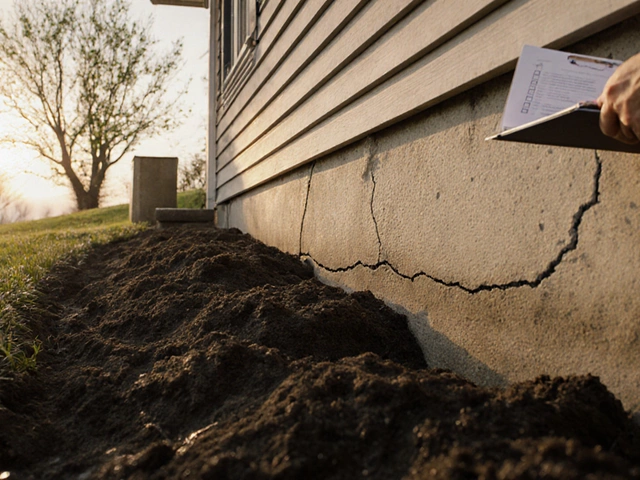Foundation Repair Season Calculator
Find Your Best Repair Season
Select your climate zone to determine the optimal season for foundation repair work.
When a house starts moving, cracking walls, or uneven floors appear, the instinct is to call a contractor right away. But the moment you pick up the phone can have a huge impact on how well the fix holds up. The best time for foundation repair depends on weather, soil conditions, and how the repair material behaves as it cures. This guide walks you through the science of the seasons, shows you how to match the climate to your project, and gives a practical checklist so you can schedule the work with confidence.
Key Takeaways
- Spring and early autumn offer the most balanced temperature and soil moisture for concrete curing.
- Extreme heat in midsummer can cause rapid drying and shrinkage, while deep freeze in winter stalls cure and may damage fresh repairs.
- Check local frost depth and groundwater table before committing to a date.
- Prepare the site by draining water and protecting the work area from rain or snow.
- Choose a contractor who monitors weather forecasts and can adjust the schedule as needed.
How Weather Influences Foundation Repairs
Foundations sit in direct contact with the ground, so they are subject to the same forces that move soil. Two main weather‑related factors affect repair success:
- Temperature the ambient air and ground heat that influences concrete setting and steel expansion.
- Soil moisture the amount of water in the earth that expands or contracts as it freezes and thaws.
Concrete used in pier or slab repairs needs a certain temperature range-typically 50°F to 85°F (10°C‑29°C)-to hydrate properly. Below that, the chemical reaction slows dramatically, leaving the material weak. Above it, moisture evaporates too fast, causing shrinkage cracks.
Meanwhile, soil that is saturated when a repair is made will continue to exert pressure on the new footing as it dries, potentially pulling the repair out of alignment. Conversely, overly dry soil can lead to uneven settlement because the ground pulls away from the foundation as it contracts.
Seasonal Pros and Cons
| Season | Typical Temperature (°F) | Soil Moisture | Pros | Cons |
|---|---|---|---|---|
| Spring (Mar‑May) | 55‑70 | Increasing after winter melt | Warm enough for cure, soil still moist enough for stability | Rain can cause runoff; need good drainage |
| Summer (Jun‑Aug) | 75‑90 | Generally drier | Long daylight hours, fast work progress | High heat accelerates drying, risk of shrinkage; need misting |
| Autumn (Sep‑Nov) | 60‑75 | Decreasing after summer | Ideal temperature range, soil still contains enough moisture | Late season rain; potential for early frosts in some regions |
| Winter (Dec‑Feb) | 30‑45 | Often frozen | Lower labor costs in some markets | Cold halts concrete cure; frozen ground makes excavation hard; risk of frost heave on new work |
The table shows why most professionals recommend late spring through early autumn for most repairs. Those months give you a temperature window where concrete can achieve 90% strength within a day, and the soil retains enough water to stay stable without excessive swelling.

Assessing Your Local Conditions
Even within the same country, climate can vary widely. In Auckland, the average winter temperature stays around 50°F (10°C) and frost is rare, making winter repairs more feasible than in colder regions. However, the area’s high rainfall means you must watch the forecast closely.
Two local metrics are especially useful:
- Frost depth the depth to which ground freezes in winter, influencing how deep you can excavate safely.
- Groundwater table the level below ground where water saturates the soil, affecting buoyancy and pressure on footings.
Contact your local council or a geotechnical engineer to get these numbers for your property. If the frost depth is shallow and the water table is high, you’ll want to avoid the coldest months when the ground can freeze around freshly poured concrete.
Preparing the Site for a Successful Repair
Once you’ve picked a window, the next step is site preparation. A well‑prepped site reduces the chance that weather will undo your work.
- Drain any standing water. Use sump pumps or temporary French drains to lower the water table for at least 24hours before concrete placement.
- Cover exposed soil with tarps if rain is forecasted within the next 48hours. This prevents the soil from becoming overly saturated.
- Heat or insulate the work area if temperatures dip below 50°F (10°C). Portable heating blankets keep the concrete temperature in the optimal range.
- Moisten the sub‑soil lightly before pouring concrete in hot, dry conditions. A thin water film slows surface evaporation and improves bonding.
- Mark the exact locations of new piers or wall anchors using stakes and string lines, so you can work efficiently when the weather window closes.
Selecting a Contractor Who Understands Seasonal Constraints
Not every contractor treats weather as a factor worth planning for. Look for a company that mentions “weather monitoring” or “seasonal scheduling” on their website or in a consultation.
Ask these questions:
- Do you have experience repairing foundations in freeze‑thaw cycles conditions where the ground repeatedly freezes and thaws?
- How do you protect fresh concrete from rapid drying or freezing?
- Can you provide a written schedule that includes buffer days for inclement weather?
- Do you work with a structural engineer a licensed professional who verifies load calculations and repair design?
A reputable contractor will often bring in a structural engineer for complex cases, ensure concrete mix designs are tailored to the season, and keep a flexible plan.

After‑Repair Maintenance: Keeping the Foundation Stable Year‑Round
The job isn’t done once the cracks are filled. Ongoing maintenance protects the investment regardless of when the repair occurred.
- Inspect the repaired area after the first heavy rain. Look for new cracks or water seepage.
- Maintain proper grading away from the house. The ground should slope at least 5% for the first 10feet.
- Install or clean gutters and downspouts regularly. Blocked drainage can raise the water table and apply pressure on the foundation.
- Consider a perimeter drainage system if your property has a high groundwater table. French drains and sump pumps can keep water away from the footings year‑round.
- Schedule a professional inspection every 2‑3years to catch early signs of movement.
By staying proactive, you can avoid the need for another seasonal repair window for many years.
Quick Checklist Before You Book the Work
- Determine the local frost depth and groundwater table.
- Choose a window between late March and early November (adjust for your climate).
- Confirm the contractor monitors weather forecasts and has a contingency plan.
- Arrange site drainage and temporary protection from rain or snow.
- Plan for post‑repair inspections and regular maintenance.
Frequently Asked Questions
Can I do foundation repair in winter if I live in a mild climate?
Yes, but you must keep the concrete temperature above 50°F (10°C) and protect the site from freezing. Portable heaters, insulated blankets, and a dry enclosure can make winter work possible in places like Auckland where frost is rare.
What if heavy rain hits during the repair?
A good contractor will have tarps or temporary roofing to shield fresh concrete. They’ll also pause excavation if the soil becomes too saturated, then resume once it drains to a workable moisture level.
How long does a typical foundation repair take?
Most residential pier or slab lifts take 2‑3days of active work, plus a curing period of 24‑48hours before foot traffic is allowed. Seasonal planning adds a few buffer days for weather delays.
Do I need a permit for foundation repair?
In most NewZealand districts, permits are required if the repair involves altering footings deeper than 1meter or changing load‑bearing walls. Always check with your local council before starting.
What’s the biggest mistake homeowners make when scheduling repairs?
Rushing to begin during the hottest or coldest months without adjusting mix designs or site protection. The result is often weakened concrete or post‑cure cracking.


Write a comment